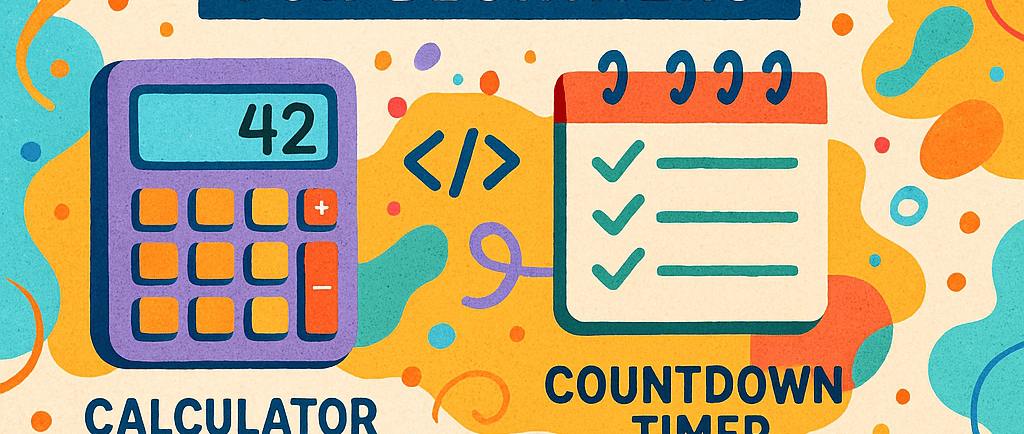
Beginner Coding Projects
Just beginner projects if you want to get a taste of coding and programming.
Shane Brown
5/29/20255 min read


Foundational Coding Projects for Aspiring Developers: A Comprehensive Guide for New Programmers
For individuals embarking on their programming journey, mastering basic coding projects serves as the cornerstone of computational thinking and technical proficiency. This guide explores five essential beginner-friendly projects—calculator development, task management applications, interactive timers, decision-making tools, and dynamic web elements—that collectively introduce core programming concepts while producing tangible, functional outcomes. Through detailed analysis of implementation strategies, pedagogical benefits, and skill development pathways, this report equips new developers with the knowledge to build confidence through hands-on practice.
Building Interactive Calculators: Mathematical Operations as Programming Fundamentals
The creation of a simple calculator represents one of the most effective entry points into programming logic. By implementing arithmetic operations through code, beginners gain exposure to variable manipulation, conditional statements, and user input handling—skills that form the bedrock of software development.
Command-Line Calculator Implementation
A Python-based console calculator demonstrates fundamental programming constructs through function definitions and control flow mechanisms. The typical implementation involves creating separate functions for addition, subtraction, multiplication, and division, followed by a menu system that processes user input to execute corresponding operations. This approach reinforces understanding of parameter passing, return values, and error handling for invalid inputs.
def add(x, y):
return x + y
def calculate():
while True:
num1 = float(input("Enter first number: "))
operator = input("Enter operator (+ - * /): ")
num2 = float(input("Enter second number: "))
if operator == '+':
result = add(num1, num2)
# Additional operations...
print(f"Result: {result}")
This structure introduces beginners to modular code organization while emphasizing the importance of data type conversion and user interface design. The visual feedback loop of input-processing-output cultivates debugging skills when handling edge cases like division by zero or non-numeric inputs.
Graphical Calculator Development
Transitioning to web technologies, HTML/CSS/JavaScript calculators introduce Document Object Model (DOM) manipulation and event-driven programming. A typical implementation features grid-based button layouts styled with CSS Flexbox, with JavaScript event listeners capturing user interactions to update display elements in real-time. This project bridges abstract programming concepts with tangible user interface design, teaching responsive layout principles alongside JavaScript arithmetic evaluation methods.
The visual component enhances learner engagement through immediate graphical feedback, while the necessity to manage state between button presses introduces fundamental concepts in application state management. Beginners learn to map user actions (button clicks) to program logic (mathematical operations), establishing critical cause-effect relationships in interactive software development.
Task Management Systems: Data Persistence and CRUD Operations
To-do list applications provide practical exposure to Create-Read-Update-Delete (CRUD) operations—the essential building blocks of data-driven applications. Through both command-line and web-based implementations, developers acquire skills in array manipulation, local storage utilization, and user interface updates.
Console-Based Task Managers
Python implementations typically utilize lists for task storage, with functions for adding, removing, and marking items as complete. The inclusion of file I/O operations to persist data between sessions introduces beginners to fundamental data persistence concepts. A basic structure might include:
tasks = []
def add_task():
task = input("Enter task: ")
tasks.append({"description": task, "completed": False})
def show_tasks():
for index, task in enumerate(tasks):
status = "✓" if task["completed"] else " "
print(f"{index+1}. [{status}] {task['description']}")
This implementation teaches dictionary data structures, loop enumeration, and boolean logic while demonstrating practical applications of list methods. The visual representation of task states through checkbox-like symbols enhances user experience in console environments.
Web-Based Task Applications
JavaScript implementations elevate complexity by introducing DOM manipulation and browser storage APIs. A typical architecture includes HTML input elements, CSS styling for visual feedback, and JavaScript classes managing application state. Key learning outcomes include event listener configuration, dynamic element creation, and localStorage usage for data persistence between sessions:
document.getElementById('addBtn').addEventListener('click', () => {
const taskText = document.getElementById('taskInput').value;
const taskItem = document.createElement('li');
taskItem.textContent = taskText; document.getElementById('taskList').appendChild(taskItem);
});
This approach introduces asynchronous programming concepts through user interaction handling while demonstrating modern web development practices. Styling completed tasks with CSS text-decoration properties reinforces the connection between JavaScript state changes and visual presentation.
Temporal Programming: Countdown Timers and Interval Management
Countdown timer projects teach temporal logic and asynchronous programming through JavaScript's setInterval function or Python's time module. These implementations introduce millisecond precision timing, display formatting, and callback functions.
Web-Based Countdown Implementation
A JavaScript timer demonstrating minutes/seconds countdown involves initializing a target time, calculating remaining duration each second, and updating display elements accordingly:
function startTimer(seconds) {
let remaining = seconds;
const interval = setInterval(() => {
const mins = Math.floor(remaining / 60).toString().padStart(2, '0');
const secs = (remaining % 60).toString().padStart(2, '0');
document.getElementById('timer').textContent = `${mins}:${secs}`;
remaining--;
if(remaining < 0) clearInterval(interval);
}, 1000);
}
This code teaches string padding for display formatting, interval-based execution, and cleanup procedures using clearInterval. The visual countdown progression helps learners conceptualize program state changes over time.
Console-Based Timer Variations
Python implementations might focus on text-based progress bars or simple second-counting mechanisms using time.sleep(). These projects emphasize loop control variables and stdout flushing techniques to create dynamic console outputs. While less visually complex than web implementations, they reinforce core timing and output manipulation concepts.
Decision Simulation: Magic 8-Ball Applications
The Magic 8-Ball project introduces random number generation and array indexing through a playful interface. Python implementations typically utilize the random module to select predefined responses from a list, teaching conditional logic and user input validation.
import random
responses = ["Yes", "No", "Maybe", "Ask again later"]
def magic_8_ball():
input("Ask a yes/no question: ")
print(random.choice(responses))
This simple structure demonstrates array manipulation, function invocation, and basic user interaction patterns. Expanding the project to include response weighting or input parsing introduces more complex programming concepts as skills progress.
Progressive Complexity Pathways
Each foundational project contains natural extension points for skill development:
Calculator Enhancements: Adding scientific functions, memory storage, or history tracking
Task Manager Upgrades: Implementing priority systems, due dates, or collaborative features
Timer Complexities: Incorporating lap functionality, multiple timers, or audio alerts
Decision Tools: Integrating natural language processing for question analysis
These progression paths allow learners to incrementally build upon initial implementations, applying new concepts like object-oriented programming or external API integration as their skills mature.
Conclusion: Building Competence Through Iterative Development
The projects outlined in this guide—spanning mathematical operations, data management, temporal logic, and interactive decision-making—provide comprehensive exposure to essential programming paradigms. By methodically implementing these applications, new developers cultivate problem-solving strategies, algorithmic thinking, and debugging techniques that form the foundation of software engineering expertise. The tangible nature of these projects reinforces conceptual understanding through visible results, while their inherent scalability supports continuous learning through feature expansion and complexity augmentation.
For aspiring programmers, the journey from simple calculator to full-featured task manager exemplifies the incremental nature of skill acquisition in software development. Each completed project not only reinforces technical competencies but also builds the psychological resilience necessary for tackling increasingly complex challenges in the technological landscape.
Nerd Joke of the Day
Why do programmers prefer dark mode?
Because light attracts bugs!
Sources
Programiz: Python Programming Examples - Calculator
YouTube: Calculator tutorials and implementations
LinkedIn: Creating Simple To-Do List Applications in Python
Educative: How to Create a Simple To-Do List with HTML, CSS, and JS
W3Schools: JavaScript Countdown Timer Tutorial
Python for Beginners: Magic 8-Ball Written in Python
DigitalOcean: How to Make a Calculator Program in Python 3
Dev.to: To-Do List Using JavaScript
Stack Overflow: Various programming discussions and solutions
The Odin Project: Calculator lesson
SitePoint: Build JavaScript Countdown Timer
CodeAcademy: Python Magic 8-Ball discussions
Vultr Docs: Python Countdown Timer Examples
The Insightful Coder: Magic 8-Ball Game Using Python
Instructables: Step-by-step Coding Tutorials
Teach with ICT: 8-Ball Tutorial
Micro:bit: Magic 8-Ball Projects
